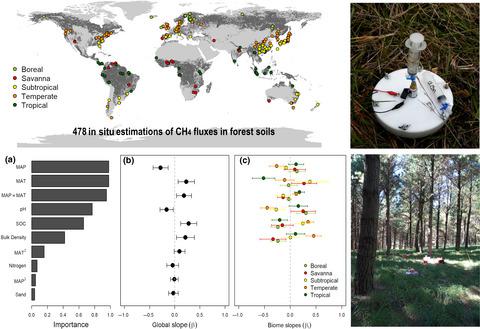当前位置:
X-MOL 学术
›
Glob. Change Biol.
›
论文详情
Our official English website, www.x-mol.net, welcomes your feedback! (Note: you will need to create a separate account there.)
Environmental and anthropogenic drivers of soil methane fluxes in forests: global patterns and among-biomes differences.
Global Change Biology ( IF 11.6 ) Pub Date : 2020-09-03 , DOI: 10.1111/gcb.15331 Gabriel Gatica 1 , María E Fernández 2, 3, 4 , Maria P Juliarena 1, 5 , Javier Gyenge 2, 3, 4
Global Change Biology ( IF 11.6 ) Pub Date : 2020-09-03 , DOI: 10.1111/gcb.15331 Gabriel Gatica 1 , María E Fernández 2, 3, 4 , Maria P Juliarena 1, 5 , Javier Gyenge 2, 3, 4
Affiliation

|
Forest soils are the most important terrestrial sink of atmospheric methane (CH4). Climatic, soil and anthropogenic drivers affect CH4 fluxes, but it is poorly known the relative weight of each driver and whether all drivers have similar effects across forest biomes. We compiled a database of 478 in situ estimations of CH4 fluxes in forest soils from 191 peer‐reviewed studies. All forest biomes (boreal, temperate, tropical and subtropical) but savannahs act on average as CH4 sinks, which presented positive fluxes in 65% of the sites. Mixed effects models showed that combined climatic and edaphic variables had the best support, but anthropogenic factors did not have a significant effect on CH4 fluxes at global scale. This model explained only 19% of the variance in soil CH4 flux which decreased with declines in precipitation and increases in temperature, and with increases in soil organic carbon, bulk density and soil acidification. The effects of these drivers were inconsistent across biomes, increasing the model explanation of observed variance to 34% when the drivers have a different slope for each biome. Despite this limited explanatory value which could be related to the use of soil variables calculated at coarse scale (~1 km), our study shows that soil CH4 fluxes in forests are determined by different environmental variables in different biomes. The most sensitive system to all studied drivers were the temperate forests, while boreal forests were insensitive to climatic variables, but highly sensitive to edaphic factors. Subtropical forests and savannahs responded similarly to climatic variables, but differed in their response to soil factors. Our results suggest that the increase in temperature predicted in the framework of climate change would promote CH4 emission (or reduce CH4 sink) in subtropical and savannah forests, have no influence in boreal and temperate forests and promote uptake in tropical forests.
中文翻译:

森林土壤甲烷通量的环境和人为驱动因素:全球格局和生物群落之间的差异。
森林土壤是大气中甲烷(CH 4)的最重要的陆地汇。气候,土壤和人为驱动因素会影响CH 4通量,但人们对每个驱动因素的相对重量以及所有驱动因素在整个森林生物群落中是否具有相似的影响知之甚少。我们从191个同行评审的研究中,汇总了478个森林土壤中CH 4通量的原位估计数据库。除萨凡纳外,所有森林生物群落(北方,温带,热带和亚热带)平均作为CH 4汇,在65%的地点呈正向通量。混合效应模型表明,气候和海平面综合变量具有最佳支持,但人为因素对CH 4的影响不明显全球范围的通量。该模型仅解释了土壤CH 4通量变化的19%,该变化随降水减少和温度升高以及土壤有机碳,容重和土壤酸化的增加而降低。这些驱动因素在整个生物群落中的影响是不一致的,当每个生物群落具有不同的斜率时,对观测到的方差的模型解释会增加到34%。尽管该解释值有限,但可能与使用粗略尺度(约1 km)计算的土壤变量有关,我们的研究表明土壤CH 4森林中的通量是由不同生物群落中不同的环境变量决定的。对所有研究过的驱动器来说,最敏感的系统是温带森林,而北方森林对气候变量不敏感,但对土壤环境高度敏感。亚热带森林和大草原对气候变量的响应类似,但对土壤因子的响应却不同。我们的结果表明,在气候变化框架内预测的温度升高将促进亚热带和热带大草原森林的CH 4排放(或减少CH 4汇),对北方和温带森林没有影响,并促进热带森林的吸收。
更新日期:2020-10-19
中文翻译:

森林土壤甲烷通量的环境和人为驱动因素:全球格局和生物群落之间的差异。
森林土壤是大气中甲烷(CH 4)的最重要的陆地汇。气候,土壤和人为驱动因素会影响CH 4通量,但人们对每个驱动因素的相对重量以及所有驱动因素在整个森林生物群落中是否具有相似的影响知之甚少。我们从191个同行评审的研究中,汇总了478个森林土壤中CH 4通量的原位估计数据库。除萨凡纳外,所有森林生物群落(北方,温带,热带和亚热带)平均作为CH 4汇,在65%的地点呈正向通量。混合效应模型表明,气候和海平面综合变量具有最佳支持,但人为因素对CH 4的影响不明显全球范围的通量。该模型仅解释了土壤CH 4通量变化的19%,该变化随降水减少和温度升高以及土壤有机碳,容重和土壤酸化的增加而降低。这些驱动因素在整个生物群落中的影响是不一致的,当每个生物群落具有不同的斜率时,对观测到的方差的模型解释会增加到34%。尽管该解释值有限,但可能与使用粗略尺度(约1 km)计算的土壤变量有关,我们的研究表明土壤CH 4森林中的通量是由不同生物群落中不同的环境变量决定的。对所有研究过的驱动器来说,最敏感的系统是温带森林,而北方森林对气候变量不敏感,但对土壤环境高度敏感。亚热带森林和大草原对气候变量的响应类似,但对土壤因子的响应却不同。我们的结果表明,在气候变化框架内预测的温度升高将促进亚热带和热带大草原森林的CH 4排放(或减少CH 4汇),对北方和温带森林没有影响,并促进热带森林的吸收。



























 京公网安备 11010802027423号
京公网安备 11010802027423号